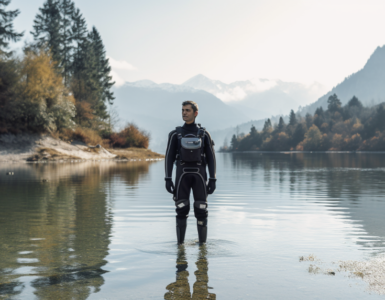If you’re a fan of water sports, you’ve probably heard of hydrofoiling. This exciting activity is gaining popularity among thrill-seekers and water enthusiasts alike. But what exactly is hydrofoiling? And is it hard to get into? Let’s dive into these questions and explore the world of hydrofoiling.
What is Hydrofoiling?
Hydrofoiling, also known as foiling, is a unique water sport that involves riding a board while a hydrofoil underneath lifts you above the water. It’s like flying on water! The hydrofoil, which looks like a wing, produces lift as you move forward, much like an airplane wing. This lift raises the board—and you—above the water’s surface, creating a sensation of gliding or floating above the water. Sounds exciting, doesn’t it?
How does Hydrofoiling Compare to Other Water Sports?
So, how does hydrofoiling stack up against other water sports? Well, like surfing or kiteboarding, hydrofoiling offers its own unique set of challenges and thrills. The most significant difference is the sensation of riding above the water’s surface. Unlike surfing where you ride on the wave, hydrofoiling gives you the feeling of flying over the water. This unique sensation is what makes hydrofoiling so appealing to many water sports enthusiasts.
But this also introduces unique challenges. Balancing on a hydrofoil board is different from a surfboard or a kiteboard. It requires a different set of skills and a good understanding of how the hydrofoil works. But don’t let this intimidate you! With practice and the right approach, you can enjoy the thrill of hydrofoiling. After all, every water sport has its learning curve, right?
Learning the Basics of Hydrofoiling
So, you’re ready to get started with hydrofoiling? That’s exciting! But before you jump on a board and hit the waves, it’s essential to understand the basics of this sport. Just like any other water sport, hydrofoiling requires certain skills and equipment to ensure a safe and enjoyable experience.
Equipment Needed for Hydrofoiling
Before you take to the water, let’s talk about the gear you’ll need. The most important piece of equipment is, of course, the hydrofoil board. This isn’t your average surfboard; it’s designed with a special foil attached to the underside that allows it to glide above the water’s surface.
Next, you’ll need a life jacket for safety and a wetsuit if you’re hydrofoiling in colder waters. Don’t forget the helmet – while it might not be the most fashionable accessory, it’s crucial for protecting your head. Lastly, a good pair of water shoes can help protect your feet and give you better control over your board.
Key Skills for Hydrofoiling
Now that we’ve covered the gear let’s talk about the skills you’ll need. First and foremost, balance is crucial. If you’ve ever tried stand-up paddleboarding, surfing, or even yoga, you’ll have a good foundation to build on. But don’t worry if you haven’t – with practice, balance can be improved!
Strength, specifically core strength, is another key skill for hydrofoiling. This is because controlling the board and maintaining your position above the water requires a strong and engaged core. Finally, you’ll need to develop a good sense of water awareness. Understanding wave patterns, wind direction, and knowing how to read the water are all crucial skills for successful hydrofoiling.
Understanding the Challenges in Hydrofoiling
While hydrofoiling is undoubtedly exhilarating, it’s not without its challenges. In fact, it’s these challenges that make it seem hard for many beginners. But remember, every sport has its learning curve, and hydrofoiling is no different.
Physical Challenges in Hydrofoiling
Physically, the challenges of hydrofoiling are primarily about balance and strength. As we’ve mentioned, maintaining your balance on a board that’s gliding above the water is not easy. It takes time, patience, and a lot of practice. Similarly, you’ll need to build up your strength, particularly in your core and legs, to control the board effectively.
Environmental Challenges in Hydrofoiling
Aside from the physical challenges, there are also environmental factors to consider. Weather conditions can greatly affect your hydrofoiling experience. For example, strong winds can make it difficult to control the board, while large waves can pose a challenge for beginners. Moreover, understanding and navigating water currents is crucial for safe and successful hydrofoiling.
Tips for Learning Hydrofoiling
So, you’re interested in learning to hydrofoil? That’s fantastic! Hydrofoiling can seem a bit daunting at first, but don’t let it intimidate you. Like any other sport, it’s all about understanding the basics and practicing regularly. Ready for some tips to get started?
- Start with the right equipment: Invest in a good quality hydrofoil board. Make sure it’s suited to your weight and skill level. Safety gear like a helmet and impact vest are also crucial.
- Take a lesson: While it’s possible to learn on your own, taking a lesson from a certified instructor can significantly speed up the learning process. They can provide valuable insights and correct your mistakes in real-time.
- Work on your balance: Balance is key in hydrofoiling. Consider practicing on a balance board or taking up yoga to improve your balance and core strength.
- Start slow: Don’t rush to get up on the foil. Spend some time getting comfortable with the board and the feeling of being in the water first.
- Stay patient: It might take a while before you can successfully ride the foil. Don’t get discouraged! Every wipeout is a step closer to gliding effortlessly over the water.
Practice Strategies for Hydrofoiling
Practice, as they say, makes perfect. This is especially true for hydrofoiling. Here are some strategies that can help you improve your hydrofoiling skills:
- Consistent practice: Try to get out on the water regularly. Even if it’s just for a short session, the more time you spend on the board, the quicker you’ll improve.
- Watch and learn: Watch experienced hydrofoilers, either in person or online. Pay attention to their stance, how they balance, and how they handle the foil. It can be a great source of inspiration and learning.
- Focus on one thing at a time: Don’t try to learn everything at once. Break down the sport into smaller skills and focus on one at a time until you master it.
- Record your sessions: If possible, record your practice sessions. This will allow you to review and identify areas that need improvement.
- Consider joining a group: Joining a local hydrofoiling group or community can be a great way to get tips, support, and motivation. Plus, it’s a lot more fun to learn and progress together!
Advancements in Hydrofoiling Technology
Ever wondered how technology has transformed the world of sports? Well, hydrofoiling is a perfect example. As with many sports, advancements in technology have made hydrofoiling more accessible to beginners. From the design of the hydrofoil itself to the equipment used, technology has played a significant role in making the sport more user-friendly.
For instance, hydrofoil boards have evolved to become lighter, stronger, and more efficient. This not only enhances performance but also makes learning easier for beginners. Isn’t that fantastic?
The Rewards of Hydrofoiling
Now, let’s talk about the rewarding aspects of hydrofoiling. What makes it worth the effort?
The thrill of gliding above the water is simply unmatched. It’s like flying on water! The feeling of speed and freedom is exhilarating, and the view from up there? It’s breathtaking!
Moreover, there’s a sense of accomplishment that comes with mastering the sport. Every time you conquer a wave or maintain balance for a longer period, it’s a victory. And who doesn’t love the feeling of achievement?
Personal Experiences
Sharing some personal experiences here, learning hydrofoiling was no doubt challenging, but it was also incredibly fun and rewarding. From the first time standing on the board to the first successful glide above the water, each step of the journey was a unique experience.
And the progression? It’s inspiring to see how one evolves from a beginner to an advanced level in this sport. Here’s a table showcasing a typical progression timeline in learning hydrofoiling:
| Stage | Skills Acquired | Duration |
|---|---|---|
| Beginner | Basic balancing, standing on board | 1-2 months |
| Intermediate | Gliding, turning, wave riding | 3-6 months |
| Advanced | Jumping, high-speed riding, complex maneuvers | 1 year+ |
Final Thoughts
So, circling back to the original question: is hydrofoiling hard? Well, it certainly has its challenges, but with the right approach, equipment, and a bit of persistence, it’s a sport that can be learned and enjoyed by many.
Remember, every expert was once a beginner. Why not give hydrofoiling a try? Embrace the thrill, conquer the challenge, and experience the unique joy of flying on water. Trust me, you’ll love it!




